Smoke meat everyday...
Smoke meat everyday...
-
-
-
-
-
-
Post #181 - May 24th, 2009, 10:45 amjimswside wrote:Should be another day of good food, drink, and sun.
Jim,
Chicken looks a treat, glad you are enjoying the WSM. (I do want it back )
)
KCBS contest I visited (up a few posts) yesterday was in Westmont, not my usual territory to say the least, so I called an audible for dinner, I had planned on smoking a salmon filet I bought at Costco, and picked up dinner at Katy's
Bright and sunny Sunday screams smoked salmon for breakfast.
Hour or two brine, turn on the Weber kettle, indirect, with lump and a bit of apple wood and Sunday brunch is elevated from the usual baked beans, rasher of bacon, black pudding, half a tomato and knob of Vegemite.
Salmon Filet, lump charcoal, bit of apple wood.
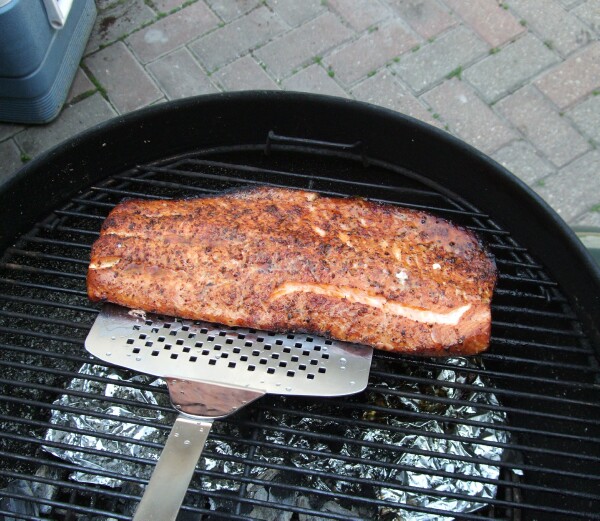
I can't arrange a plate worth sh*t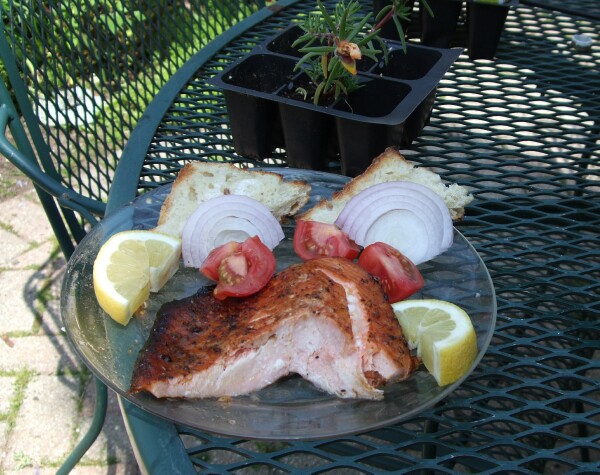
But I do know how to smoke some salmon
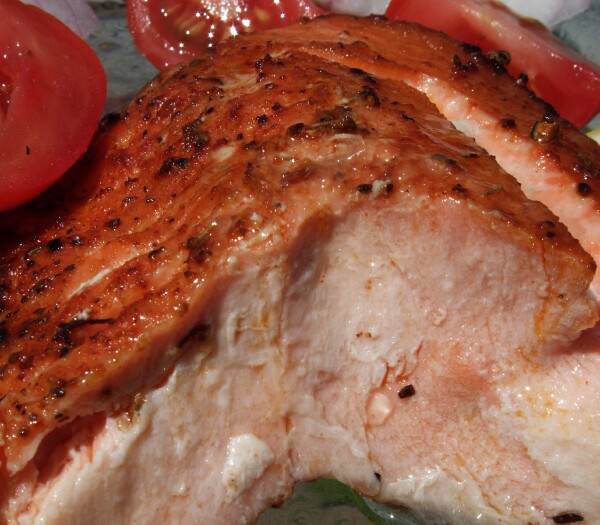
Enjoy,
Gary
-
-
Post #182 - May 24th, 2009, 12:30 pmAs the proud owner of a brand new WSM, I decided to christen the beauty by trying to duplicate GWiv's magnificent buttermilk brined chicken from MiM.

Virgin WSM
I used the Buttermilk Brine from Low & Slow, but modified by subbing GWiv's Rub™ for Old Bay and adding a few rough chopped jalapenos and smashed garlic cloves. After air-drying the chicken in the fridge, I finished all but one of the quarters with a healthy rubbing of GWiv's Rub™
As a learning device, I left one of the quarters rub-free so that I could taste the unadulterated effect of the brining. I was shocked at how much flavor the brine alone gave the chicken. As it turns out, the rub was just a condiment. All of the wonderful, spicy flavor was already in the brined chicken.
Mmmmm...
REB proclaimed it to be some of the best chicken she has ever had -- almost as good as GWiv's. That's either honest high praise or unconditional love and support. Either way, I'm golden.
I have a taste memory from my youth of a long defunct rib joint in Pittsburgh that had a side dish of smoked potatoes. I had some potatoes lying around, so I gave it a shot. I cut some baking potatoes into chunks and tossed them with garlic, olive oil, lemon juice and chopped herbs. I added them to the WSM for the last 45 minutes that the chicken was cooking. Unfortunately, my experiment was a failure. The potatoes were not fully cooked when the chicken was done, and they had little to no smoke flavor. I finished them in the oven, but we were still not thrilled. I'll try again.
Taters
The WSM worked like a charm. I followed the instructions in L&S and the sucker held a perfect 275° for the entire cook (and for several hours after). For the many of you who have heard me whine about my old, rusty offset, thank you so much for suggesting the WSM. I'm in love.
--RichI don't know what you think about dinner, but there must be a relation between the breakfast and the happiness. --Cemal Süreyya
-
-
Post #183 - May 24th, 2009, 4:47 pmanother great afternoon ont he deck in Marseilles.
Used the WSM, but admittedly strayed from the Low and Slow bible for the ribs. I didnt boil them or bake them in the oven so I think i am ok.. WSM held a consisant temp, mostly hovering int he 245 range. what a grat piece of equiptment.
WSM held a consisant temp, mostly hovering int he 245 range. what a grat piece of equiptment.
smoked the ribs on the WSM for about 3 hours. Then god forbid, I wrapped them in foil with honey, and some other ingredients for 30 minutes to finish. Best ribs I have ever eaten, or turned out.
I also grilled some corn on the Weber Kettle, smoked some kilbasa to put in my beans, and I did use a recipe for Mac-n-cheese from Low and Slow that was brilliant.
here are the pics, enjoy, I sure as heck did
ribs with mustard slather, and rub:
ribs and kilbasa: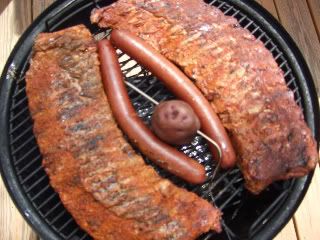
ribs on foil: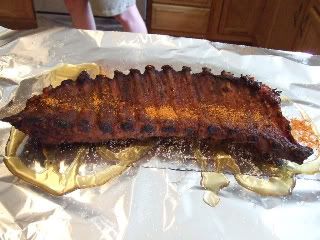
Gary's Mac-n-cheese: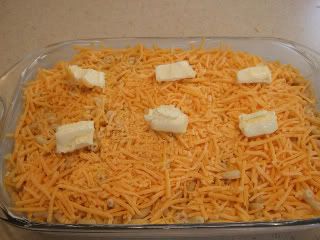
offset in the garage, loaner WSM, and my kettle: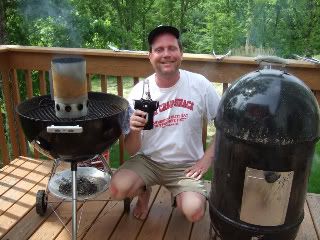
finished slabs: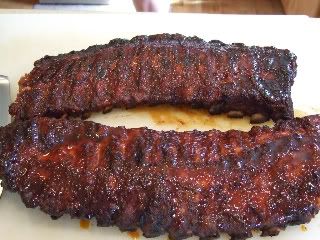
sliced ribs: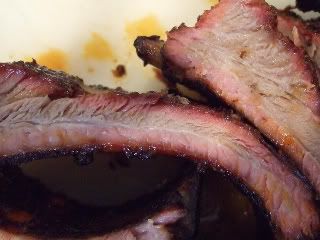
In the words of the Hawk... Mercy..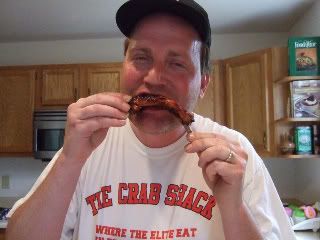
the feast:
thanks for looking at my pics.
-
-
Post #184 - May 24th, 2009, 9:00 pmjimswside wrote:Used the WSM, but admittedly strayed from the Low and Slow bible for the ribs. I didnt boil them or bake them in the oven so I think i am ok..
 WSM held a consisant temp, mostly hovering int he 245 range. what a grat piece of equiptment.
WSM held a consisant temp, mostly hovering int he 245 range. what a grat piece of equiptment.
smoked the ribs on the WSM for about 3 hours. Then god forbid, I wrapped them in foil with honey, and some other ingredients for 30 minutes to finish. Best ribs I have ever eaten, or turned out.
In the good old days when I was a beta tester, straying as you did would have gotten me kicked out of the program. Gary would not have given me the next class until I did it precisely as stated and had sent pictures in for his approval.
It's really too bad the new WSM has a thermometer built in. By straying and following the temperature readings, you miss an important element of his method: acquiring an intuitive sense of how the cook is progressing.
I got my diploma, will you?
Regards,Cathy2
"You'll be remembered long after you're dead if you make good gravy, mashed potatoes and biscuits." -- Nathalie Dupree
Facebook, Twitter, Greater Midwest Foodways, Road Food 2012: Podcast
-
-
Post #185 - May 25th, 2009, 6:03 amHere is a video from the New York Times on how to "thrice" cook ribs. Warning: it is horrifying to watch.
http://www.youtube.com/watch?v=G4vw6kBtMUE
The video is the absolute antithesis of everything Gary teaches. The guy in the video is absolutely clueless. His excuse is that the weather in NY is unpredictable on Memorial day, so you have to boil and broil your ribs "just in case". And he calls himself "The Minimalist". Besides, since when has a little rain (or sleet, or snow), stopped any of us from smoking things right?
-
-
Post #186 - May 25th, 2009, 7:13 amd4v3 wrote:Here is a video from the New York Times on how to "thrice" cook ribs. Warning: it is horrifying to watch.
Yikes!
At least at no point, that I remember, did Bittman call them anything but thrice-cooked or grilled ribs.
If you are in the mood for a BBQ video Edible Chicago just put up one they took last year of me starting the fire in a WSM.
Enjoy,
Gary
-
-
Post #187 - May 25th, 2009, 8:06 amCathy2 wrote:
It's really too bad the new WSM has a thermometer built in. By straying and following the temperature readings, you miss an important element of his method: acquiring an intuitive sense of how the cook is progressing.
For the record I was getting temp readings from a probe stuck in a potato on the grate, didnt need to open up the smoker to get an idea of internal temps(I noted the temp because I was impressed with how steady of a temp the WSM kept for hours after closing 2 of the lower vents by 1/3). Also I was just monitoring the temp as adivised in lesson # 3 of the book, although the book recommends an oven thermometer on the grate. With the probe, after flipping the ribs I was able to keep the smoker closed undisturbed for 2 hours, monitoring the water level through the side door. I believe the only thing I did that varied form the lesson was I foiled the ribs.
BBQ is great in this way, so many techniques, so many opinions, etc, & as long as your not boiling, baking, etc, and get that smoke ring in the end is all that matters to me. I just want to enjoy the bbq I put on my table, & last night I did more than ever. These ribs were cooked slow and low using lump, and hickory, and foiled for 30 minutes in the end to take them to where I wanted them to be texture/taste wise.
its all good.
-
-
Post #188 - May 25th, 2009, 8:50 amHey LTH,
I have two pork shoulders smoking on the WSM as I write this post. While I was at Peoria Packing, I decided to pick up some rib tips as well. I've never cooked tips before, and I'm wondering if there's any secret to them. I was thinking I would throw them on when the pork butts have about three hours left.
Any advice?
I just picked up my copy of Low and Slow, but I couldn't find any direction on rib tips. I'm not surprised, tips are not a very uniform cut, so I imagine it's hard to affix a particular cook time.
Also, does anyone know if Uncle John's is open today? I wouldn't mind grabbing some Hot Links to throw on with the tips.
Thanks!
Rob C.
-
-
Post #189 - May 25th, 2009, 10:28 am
Tips cook pretty much like ribs. 3 hours seems adequate, but I would put them on a little bit earlier just to be sure. You can always pull them off if they get too done. I am just thinking that the shoulders are going to absorb most of the heat in the vessel, prolonging the cooking time for the tips. That's a pretty full WSM. I like to partially chop the tips before smoking to give them more surface area for greater smoke absorption, rather than throw the whole cartilage on the grate.Rob C wrote:Hey LTH,
I've never cooked tips before, and I'm wondering if there's any secret to them. I was thinking I would throw them on when the pork butts have about three hours left.
Any advice?
-
-
Post #190 - May 26th, 2009, 11:35 amMy summer food project is too perfect the art of jerked pork like that found throughout the island of Jamaica. Its my goal to get as close to the real thing as possible. It will never be as good due to the fact of a lack of pimento wood being available in the US and if you want to take it a step further to being as authentic as possible you also need fresh branches from the trees to hold the meat over the wood/fire. I started making jerked pork after my 2nd trip to Negril when I was in college at Madison. My first try out was going to be with what we used back at school, country style ribs with bones.
The country ribs were patted down heavily with one of the many different jerk paste's that I got at Danny's Old World Carib/African Market on Broadway
The well coated ribs spent about 4 hours on indirect heat with charcoal layered with chunks of hickory and allspice berries thrown on top every hour or so.
After they came off the grill it was time to chop it into pieces with the machete. Bones and all.
One reason it is experiment time this summer is I have 2 bottles of homemade jerk sauce from Bourbon beach in Negril, Jamaica in my fridge and this stuff is fire in both heat and flavor. Meaning its amazing. Its not really a marinade but rather sauce to dip your pieces of pork in as you eat. The BBQ sauce of the island so to say.
I served it on top Bahamian rice and peas (from The BBQ Bible by Steve Raichlen) on topped it off with some hot pepper slices to tone down the heat from the paste and sauce.
All in all it was damn close in flavor and texture but not as juicy as I would have liked it. It was a little dry. Maybe the country style ribs aren't fatty enough? I plan on trying it with rib tips next and I know they use a full pigs hip at Ossies Smoke Shack in Negril.
any suggestions and tips from the experts would be much respected mon. Titus.
Jerked Pork from various vendors in Negril
-
-
Post #191 - May 26th, 2009, 12:18 pmDa Beef wrote:The well coated ribs spent about 4 hours on indirect heat with charcoal layered with chunks of hickory and allspice berries thrown on top every hour or so.

After they came off the grill it was time to chop it into pieces with the machete. Bones and all.
nice job, it looks like you got some nice smoke penetration on those country ribs.
-
-
Post #192 - May 26th, 2009, 1:07 pmstevez wrote:What's that thing next to the stove/smoker with the gas bottle? Is that some kind of outdoor oven? What's that doing at a KCSB BBQ Contest?

that person was not in the kcbs contest.they had a backyard contest as well which was where that stove smoker was being used.
The propane was used to fire the burners..yes it had fully functional burners.
the meat was cooked in the oven portion acting as a cook chamber and the slide out broiler portion was filled with charcoal and wood chunks.First Place BBQ Sauce - 2010 NBBQA ( Natl BBQ Assoc) Awards of Excellence
-
-
Post #193 - May 26th, 2009, 1:14 pmHead's Red BBQ wrote:stevez wrote:What's that thing next to the stove/smoker with the gas bottle? Is that some kind of outdoor oven? What's that doing at a KCSB BBQ Contest?

that person was not in the kcbs contest.they had a backyard contest as well which was where that stove smoker was being used.
The propane was used to fire the burners..yes it had fully functional burners.
the meat was cooked in the oven portion acting as a cook chamber and the slide out broiler portion was filled with charcoal and wood chunks.
Bill,
I believe Steve was referring, in a humorous fashion, to the silver colored straight-up gas grill on the left of the stove smoker.
Enjoy,
Gary
-
-
Post #194 - May 26th, 2009, 3:22 pmG Wiv wrote:I believe Steve was referring, in a humorous fashion, to the silver colored straight-up gas grill on the left of the stove smoker.
Enjoy,
Gary
Yes, I was. To me a gas powered grill is nothing more than an outdoor oven. You can quote me on that! Steve Z.
Steve Z.
“Only the pure in heart can make a good soup.”
― Ludwig van Beethoven
-
-
Post #195 - May 26th, 2009, 7:52 pmI usually smoke my ribs the 3-2-1 method. But this time, instead of wrapping them in foil for 2 hours, I just gently covered them in foil. I was looking for a rib with a little pull on it. I feel that when they are tightly wrapped they almost braise and fall off the bone. There is probably a valid argument that the ribs are too smokey when just covered in foil, but I prefer it this way as long as I achieve the texture. I used hickory wood.




-
-
Post #196 - May 27th, 2009, 6:31 amjimswside wrote:Cathy2 wrote:
It's really too bad the new WSM has a thermometer built in. By straying and following the temperature readings, you miss an important element of his method: acquiring an intuitive sense of how the cook is progressing.
For the record I was getting temp readings from a probe stuck in a potato on the grate, didnt need to open up the smoker to get an idea of internal temps(I noted the temp because I was impressed with how steady of a temp the WSM kept for hours after closing 2 of the lower vents by 1/3). Also I was just monitoring the temp as adivised in lesson # 3 of the book, although the book recommends an oven thermometer on the grate. With the probe, after flipping the ribs I was able to keep the smoker closed undisturbed for 2 hours, monitoring the water level through the side door. I believe the only thing I did that varied form the lesson was I foiled the ribs.
BBQ is great in this way, so many techniques, so many opinions, etc, & as long as your not boiling, baking, etc, and get that smoke ring in the end is all that matters to me. I just want to enjoy the bbq I put on my table, & last night I did more than ever. These ribs were cooked slow and low using lump, and hickory, and foiled for 30 minutes in the end to take them to where I wanted them to be texture/taste wise.
its all good.
Jim - nothing wrong with knowing what your cooker temp is at ..why would one not want to?
Like you say its all good..many roads to the same destination..First Place BBQ Sauce - 2010 NBBQA ( Natl BBQ Assoc) Awards of Excellence
-
-
Post #197 - May 27th, 2009, 7:23 amHead's Red BBQ wrote:Jim - nothing wrong with knowing what your cooker temp is at ..why would one not want to?
Like you say its all good..many roads to the same destination..
Bill,
Even though he is an experienced smoker Jim is going through the 5-Lessons in Low & Slow and one of the basic building blocks is to learn to rely on sight, sound, taste, touch and smell. Not thermometers, magic forks or remote probes, 5-senses cooking if you will.
As you said, many roads to the same destination.
Enjoy,
Gary
-
-
Post #198 - May 27th, 2009, 7:45 amG Wiv wrote:
Even though he is an experienced smoker Jim is going through the 5-Lessons in Low & Slow
admittedly, at times a self induced, bastardized version of your great 5-step program.
I always was a bad student, and couldnt wait to be done with school. Darn ADD.
With the above said Low and Slow has been a great tool, and resource, and I respect the method you lay out in it alot.Last edited by jimswside on May 27th, 2009, 7:53 am, edited 1 time in total.
-
-
Post #199 - May 27th, 2009, 7:51 amRAB - on the smoked potato front, see this thread I started some time back:
http://www.lthforum.com/bb/viewtopic.php?f=16&t=24395
While the potatoes are smoked whole on a skewer, not cubed as in your photo, I think this would provide a strong start toward the dish you seek. The onions also turned out great and made wonderfully smoky and crispy home fries the following morning, and twice-baked using smoked potatoes are now in great demand in the Davooda household.
DavoodaLife is a garden, Dude - DIG IT!
-- anonymous Colorado snowboarder whizzing past me March 2010
-
-
Post #200 - May 27th, 2009, 8:15 amG Wiv wrote:Head's Red BBQ wrote:Jim - nothing wrong with knowing what your cooker temp is at ..why would one not want to?
Like you say its all good..many roads to the same destination..
Bill,
Even though he is an experienced smoker Jim is going through the 5-Lessons in Low & Slow and one of the basic building blocks is to learn to rely on sight, sound, taste, touch and smell. Not thermometers, magic forks or remote probes, 5-senses cooking if you will.
As you said, many roads to the same destination.
Enjoy,
Gary
Gary -understood.. but do you really not monitor cooker temp?
I know you are against checking meat temp throughout a cook with remote thermomoters and such and instead rely on look and feel which many do (myself included).
I just see way too much variance in heat levels from one cook to another on a wsm to just set the vents at one position for every cook (unless Im misinterpreting whats being said in this thread)..too many outside factors contribute to the cooker temp (wind, cold, heat, rain).how would one monitor cooker temp with "look and feel" ?First Place BBQ Sauce - 2010 NBBQA ( Natl BBQ Assoc) Awards of Excellence
-
-
Post #201 - May 27th, 2009, 8:17 amstevez wrote:G Wiv wrote:I believe Steve was referring, in a humorous fashion, to the silver colored straight-up gas grill on the left of the stove smoker.
Enjoy,
Gary
Yes, I was. To me a gas powered grill is nothing more than an outdoor oven. You can quote me on that!
all i know is once i saw how the gas was rigged up on that stove I didnt want to stand around too long to study it..I was half exepcting an explosion at some point First Place BBQ Sauce - 2010 NBBQA ( Natl BBQ Assoc) Awards of Excellence
First Place BBQ Sauce - 2010 NBBQA ( Natl BBQ Assoc) Awards of Excellence
-
-
Post #202 - May 27th, 2009, 8:24 amHead's Red BBQ wrote:Gary -understood.. but do you really not monitor cooker temp?
Bill,
I am specifically referring to the first 5-lessons in Low & Slow.
My methodology is to keep the learning experience as simple as possible, to that effect I've found that the general emphasis on magic rubs, sauces, absolute time, temp and various high tech equipment detract from the learning experience. Each of the 5-lessons slightly increase in difficulty, building on each step as one moves through the program.
Low and Slow is a Forest for the Trees teaching method, people see the 5-lessons as learning to cook chicken, ribs and pork shoulder
- The Trees.
What one is actually learning is basics of fire control, smoke preference, 5-senses clues as to when various meats are ready and overall confidence in their ability to produce Low and Slow BBQ
- The Forest.
As the 5-Lessons progress there are minimal recommended vent changes, and an oven thermometer is placed on the top cooking grate simply to reinforce what one is learning.
You are taking bits of the 5-Lessons program out of context as your focus, in context the program both works and makes sense.
Regards,
Gary
-
-
Post #203 - May 27th, 2009, 8:30 amG Wiv wrote:Head's Red BBQ wrote:Gary -understood.. but do you really not monitor cooker temp?
Bill,
I am specifically referring to the first 5-lessons in Low & Slow.
My methodology is to keep the learning experience as simple as possible, to that effect I've found that the general emphasis on magic rubs, sauces, absolute time, temp and various high tech equipment detract from the learning experience. Each of the 5-lessons slightly increase in difficulty, building on each step as one moves through the program.
Low and Slow is a Forest for the Trees teaching method, people see the 5-lessons as learning to cook chicken, ribs and pork shoulder
- The Trees.
What one is actually learning is basics of fire control, smoke preference, 5-senses clues as to when various meats are ready and overall confidence in their ability to produce Low and Slow BBQ
- The Forest.
As the 5-Lessons progress there are minimal recommended vent changes, and an oven thermometer is placed on the top cooking grate simply to reinforce what one is learning.
You are taking bits of the 5-Lessons program out of context as your focus, in context the program both works and makes sense.
Regards,
Gary
gary - I wasnt even referring to the low and slow book nor saying its right or worng or the philospophy behind it..
I am just asking about how one monitors cooker temp by look and feel ,,.thats all..
no sarcasm or hidden motives intendedFirst Place BBQ Sauce - 2010 NBBQA ( Natl BBQ Assoc) Awards of Excellence
-
-
Post #204 - May 27th, 2009, 8:32 amHead's Red BBQ wrote:Gary -understood.. but do you really not monitor cooker temp?
Bill,
I should add in my day to day cooking, be it 80 degrees or -10 I do not use any type of temperature checking device, haven't for years.
Not a thermometer in sight


Regards,
Gary
-
-
Post #205 - May 27th, 2009, 8:45 amHead's Red BBQ wrote:I am just asking about how one monitors cooker temp by look and feel ,,.thats all..
no sarcasm or hidden motives intended
Bill,
You are assuming I agree with the prevailing philosophy that absolute cooker temp is important, I do not and, in general, I tend to cook hotter than most BBQ guys, but am happy with cooker temps anywhere from 225 - 275.
A wider range of temperatures provide textural highlights, i.e. bark, and I'm a fan of crunchy, spicy, caramelized, juicy, fatty, rich, smoky. Temps in the 210-220 range for the full cook often yield even textured somewhat neutral flavored BBQ. Point/counterpoint, yin/yang appeal to me in BBQ as well as life.
Far as how does one learn how to cook BBQ simply by look, feel, sight etc, the same way one gets to Carnegie Hall, practice, practice, practice.
Regards,
Gary
-
-
Post #206 - May 27th, 2009, 8:54 amG Wiv wrote:Head's Red BBQ wrote:I am just asking about how one monitors cooker temp by look and feel ,,.thats all..
no sarcasm or hidden motives intended
Bill,
You are assuming I agree with the prevailing philosophy that absolute cooker temp is important, I do not and, in general, I tend to cook hotter than most BBQ guys, but am happy with cooker temps anywhere from 225 - 275.
A wider range of temperatures provide textural highlights, i.e. bark, and I'm a fan of crunchy, spicy, caramelized, juicy, fatty, rich, smoky. Temps in the 210-220 range for the full cook often yield even textured somewhat neutral flavored BBQ. Point/counterpoint, yin/yang appeal to me in BBQ as well as life.
Far as how does one learn how to cook BBQ simply by look, feel, sight etc, the same way one gets to Carnegie Hall, practice, practice, practice.
Regards,
Gary
no assumptions or what temp you cook at ..Im just asking a very specific question..
how does one monitor cooker temp by look and feel on a WSM?. In other words how does one sense heat levels by sight or feel on a wsm? You just light your fire ..set your vents and thats it? how do you know when to adjust a vent here and there without knowing what the actual temp is in the cooker?First Place BBQ Sauce - 2010 NBBQA ( Natl BBQ Assoc) Awards of Excellence
-
-
Post #207 - May 27th, 2009, 9:00 amHead's Red BBQ wrote:no assumptions or what temp you cook at ..Im just asking a very specific question..
how does one monitor cooker temp by look and feel on a WSM?. In other words how does one sense heat levels by sight or feel on a wsm? You just light your fire ..set your vents and thats it? how do you know when to adjust a vent here and there without knowing what the actual temp is in the cooker?
I can't answer for how Gary does it, but I'm able to very accurately judge the temp simply by holding my hand over the top vent and feeling the amount of heat coming out. This works for me even on the hottest or coldest days of the year. I also know that if it's real windy, for example, I've got to adjust the position of the bottom vents or at least the amount I open or close them. As Gary said, practice, practice, practice.Steve Z.
“Only the pure in heart can make a good soup.”
― Ludwig van Beethoven
-
-
Post #208 - May 27th, 2009, 9:09 amstevez wrote:Head's Red BBQ wrote:no assumptions or what temp you cook at ..Im just asking a very specific question..
how does one monitor cooker temp by look and feel on a WSM?. In other words how does one sense heat levels by sight or feel on a wsm? You just light your fire ..set your vents and thats it? how do you know when to adjust a vent here and there without knowing what the actual temp is in the cooker?
I can't answer for how Gary does it, but I'm able to very accurately judge the temp simply by holding my hand over the top vent and feeling the amount of heat coming out. This works for me even on the hottest or coldest days of the year. I also know that if it's real windy, for example, I've got to adjust the position of the bottom vents or at least the amount I open or close them. As Gary said, practice, practice, practice.
well at least thats an answer to the question Steve.
Im sure that method gets you in the ballpark temp wise.. very accurately? im not so convinced..but thanks for the input ..
you have to understand that I started out on an offset many years ago where temps fluctuate wildly and those temp fluctuations can really kill a piece of meat..just guessing cooker temps wouldnt cut it..although the WSM does maintain more solid cooker temps I have seen it fluctuate at times from top grate to bottom grate so hand over top vent doesnt seem to be all that accurate a measure (for me at least)First Place BBQ Sauce - 2010 NBBQA ( Natl BBQ Assoc) Awards of Excellence
-
-
Post #209 - May 27th, 2009, 9:12 amHead's Red BBQ wrote:no assumptions or what temp you cook at ..Im just asking a very specific question..
how does one monitor cooker temp by look and feel on a WSM?. In other words how does one sense heat levels by sight or feel on a wsm? You just light your fire ..set your vents and thats it? how do you know when to adjust a vent here and there without knowing what the actual temp is in the cooker?
Bill,
You want to know all my secrets without paying $19.95 for Low & Slow, geeesh, buy a book for gosh sakes.
Sight - Color and volume of smoke coming out of the vent.
Smell - Burning smell, toasty carmelization aroma, neutral odor.
Sound - Is the fire crackling, do you hear sizzling fat on the waterpan.
Touch - Hold your hand over the vent, with a little practice you can tell general range of temperature quite easily. In addition, when I check temp in this fashion I smell the exhaust for signs of how the fire is burning.
Taste - Obviously one can not taste temperature, but a small nibble of the outside of a pork shoulder can speak volumes about fire management.
The above is not a complete listing, just want to give you an idea of my thought process.
These clues extend to when the meat is done as well, for example a properly done pork shoulder will slump upon itself, the bone will twist easily and a two tined meat fork slides easily into the pig flesh.
Once again, this takes practice, the 5-lessons are designed to start one along the path of 5-senses BBQ cookery.
Regards,
Gary
-
-
Post #210 - May 27th, 2009, 9:20 amG Wiv wrote:Head's Red BBQ wrote:no assumptions or what temp you cook at ..Im just asking a very specific question..
how does one monitor cooker temp by look and feel on a WSM?. In other words how does one sense heat levels by sight or feel on a wsm? You just light your fire ..set your vents and thats it? how do you know when to adjust a vent here and there without knowing what the actual temp is in the cooker?
Bill,
You want to know all my secrets without paying $19.95 for Low & Slow, geeesh, buy a book for gosh sakes.
Sight - Color and volume of smoke coming out of the vent.
Smell - Burning smell, toasty carmelization aroma, neutral odor.
Sound - Is the fire crackling, do you hear sizzling fat on the waterpan.
Touch - Hold your hand over the vent, with a little practice you can tell general range of temperature quite easily. In addition, when I check temp in this fashion I smell the exhaust for signs of how the fire is burning.
Taste - Obviously one can not taste temperature, but a small nibble of the outside of a pork shoulder can speak volumes about fire management.
These clues extend to when the meat is done as well, for example a properly done pork shoulder will slump upon itself, the bone will twist easily and a two tined meat fork slides easily into the pig flesh.
Once again, this takes practice, the 5-lessons are designed to start one along the path of 5-senses BBQ cookery.
Regards,
Gary
im not fishing for secrets gary as im happy with my methods..like you it took many years of practice ( on a variety of smoker types ) and its been very successful for me and really not all that much different than yours or anyone elses when it comes to low and slow cooking
Im just discussing bbq and wanted to know how one would measure cooker temp like that and why it would be frowned upon to have a more accurate measure..thanks for answering
and again i was referring to cooker temp monitoring not meat temp monitoring
you keep adding in how to tell when meats done..completely different thing IMO and not what I was asking.First Place BBQ Sauce - 2010 NBBQA ( Natl BBQ Assoc) Awards of Excellence

